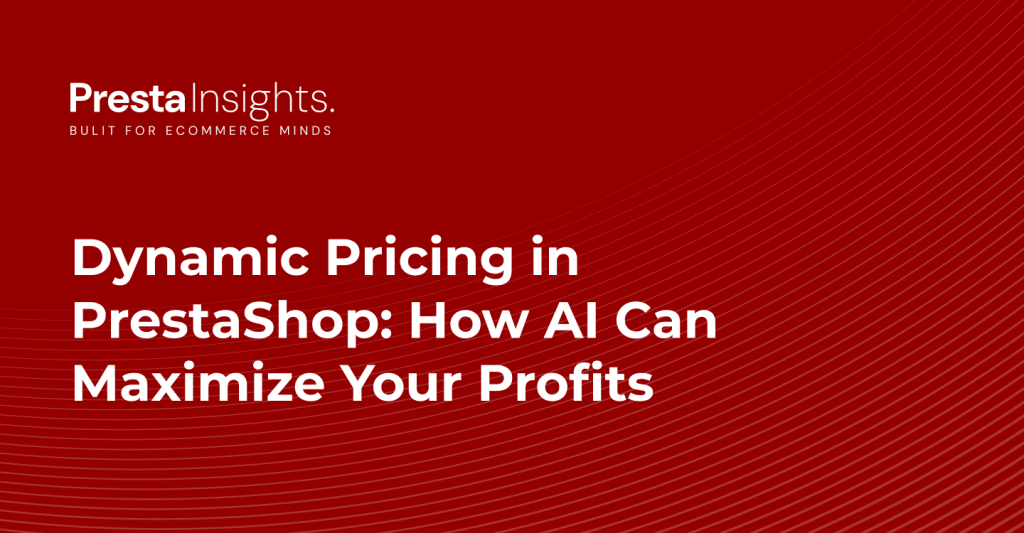Sure! Here’s a detailed, SEO-focused blog post for PrestaInsights on the topic:
Introduction
In the fiercely competitive world of eCommerce, the ability to adjust your pricing in real-time can be a game-changer. That’s where dynamic pricing comes in—a strategy that adapts product prices based on market demand, competitor behavior, and customer trends.
If you’re running a store on PrestaShop, leveraging AI-driven dynamic pricing can significantly boost your margins and keep you ahead of the curve.
1. What Is Dynamic Pricing?
Dynamic pricing refers to the practice of automatically adjusting product prices using algorithms and real-time data. These adjustments are based on factors such as:
- Supply and demand
- Competitor prices
- Customer behavior and segmentation
- Seasonality or time of day
Benefits:
- Maximizes profits
- Increases competitiveness
- Improves customer satisfaction through personalized offers
2. Why Dynamic Pricing Matters in PrestaShop
PrestaShop, as a flexible open-source eCommerce platform, allows merchants to integrate advanced modules and third-party AI tools to implement dynamic pricing strategies.
Key advantages:
- Flexibility to define rules and triggers
- Customizable to specific niches
- Compatible with external AI pricing APIs
3. How AI Powers Smart Pricing Decisions
AI enhances traditional pricing strategies by analyzing massive datasets and making intelligent decisions faster than humans. Here’s how:
- Predictive Analytics: AI forecasts customer behavior and purchase probability.
- Competitor Monitoring: AI tools scrape competitor pricing and adjust your products accordingly.
- Real-Time Updates: Prices are updated instantly based on real-world changes.
4. Best AI Tools for Dynamic Pricing in PrestaShop
Here are some top-rated tools and modules compatible with PrestaShop:
4.1 Prisync for PrestaShop
- Monitors competitor prices
- Sets dynamic pricing rules
- Integrates seamlessly via API
4.2 Omnia Dynamic Pricing (Custom Integration)
- AI-driven retail pricing
- Suits enterprise-level stores
- Offers high-level personalization
4.3 Repricer AI Tools (Amazon-Focused, Multi-Channel)
- Useful if you sell on Amazon & PrestaShop
- Syncs pricing strategy across platforms
5. Steps to Implement Dynamic Pricing in PrestaShop
Step 1: Identify Key Products for Pricing Strategy
- Focus on bestsellers, price-sensitive items, or seasonal products.
Step 2: Choose a Dynamic Pricing Tool
- Go for tools with AI-based suggestions, analytics, and PrestaShop compatibility.
Step 3: Set Rules and Parameters
- Set minimum and maximum price boundaries.
- Define frequency of price checks.
Step 4: Monitor & Optimize
- Use dashboards and reports to track pricing performance.
- Adjust based on market trends and customer response.
6. Best Practices for Dynamic Pricing
- Avoid Over-Aggressive Pricing: It may damage brand trust or erode margins.
- Segment Your Audience: Different prices for different customer types (VIPs, new customers, etc.)
- A/B Test Pricing Strategies: See what performs best before full rollout.
- Transparency: Ensure pricing changes are logical and justifiable.
7. Dynamic Pricing Use Cases in eCommerce
- Flash Sales: Real-time price drops for a limited time.
- Abandoned Cart Recovery: Offer a better deal if a cart is abandoned.
- Bulk Purchases: Offer tiered pricing based on quantity.
- Customer Location: Adjust pricing based on regional demand and costs.
8. How Dynamic Pricing Builds Competitive Advantage
- Faster Market Adaptation: React to changes before competitors.
- Customer Personalization: Increase conversions with pricing that matches willingness to pay.
- Profit Optimization: Sell at the highest price the customer is willing to pay.
9. Challenges and How to Overcome Them
| Challenge | Solution |
|---|---|
| Customer distrust due to fluctuating prices | Be transparent and offer value-based justifications |
| Complexity in managing multiple SKUs | Use AI tools that can handle large catalogs |
| Legal/ethical concerns | Avoid discriminatory pricing or price manipulation |
10. Future of Dynamic Pricing in PrestaShop
As AI becomes more advanced, we’ll see:
- Real-time demand prediction
- Hyper-personalized offers
- Integration with AI chatbots for price negotiation
Conclusion
Adopting AI-powered dynamic pricing in your PrestaShop store isn’t just a modern trend—it’s a smart business move. By staying responsive to market signals and customer behavior, you can enhance your store’s competitiveness, boost profits, and foster better customer satisfaction.
FAQs
Q1: Is there a free AI tool for dynamic pricing in PrestaShop?
Some tools like Prisync offer free trials, but most require a subscription for full features.
Q2: Can dynamic pricing harm customer trust?
If done transparently and ethically, it enhances value perception.
Q3: How often should I change prices using AI?
Ideally, let the AI monitor and adjust based on set parameters, usually daily or in real-time for fast-moving products.
Q4: Can small stores benefit from dynamic pricing?
Absolutely! Even a handful of optimized products can increase margins significantly.



